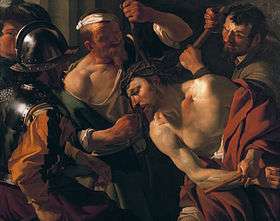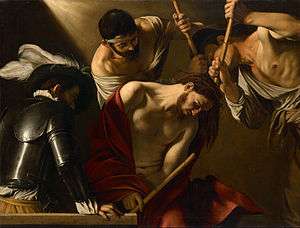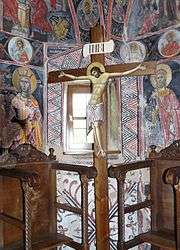Jesus, King of the Jews
In the New Testament, Jesus is referred to as the King of the Jews (or of the Judeans), both at the beginning of his life and at the end. In the Koine Greek of the New Testament, e.g., in John 19:3, this is written Basileus ton Ioudaion (βασιλεὺς τῶν Ἰουδαίων).[1]

Both uses of the title lead to dramatic results in the New Testament accounts. In the account of the Nativity of Jesus in the Gospel of Matthew, the wise men (i.e., Magi) who come from the east call Jesus the "King of the Judeans", causing King Herod to order the Massacre of the Innocents. Towards the end of the accounts of all four canonical Gospels, in the narrative of the Passion of Jesus, the title "King of the Judeans" leads to charges against Jesus that result in his crucifixion.[2][3] The name Judea is a Greek and Roman adaptation of the name "Judah", which originally encompassed the territory of the Israelite tribe of that name and later of the ancient Kingdom of Judah.
The initialism INRI (Latin: Iēsus Nazarēnus, Rēx Iūdaeōrum) represents the Latin inscription (in John 19:19), which in English translates to "Jesus the Nazarene, King of the Jews", and John 19:20 states that this was written in three languages—Hebrew, Latin, and Greek—during the crucifixion of Jesus.
The title "King of the Jews" is only used in the New Testament by gentiles, namely by the Magi, Pontius Pilate, and the Roman soldiers. In contrast, the Jewish leaders use the designation "King of Israel".[2] Although the phrase "King of the Jews" is used in most English translations,[4] it has also been translated "King of the Judeans" (see Ioudaioi).[5]
Use in the Nativity
In the account of the Nativity of Jesus in the Gospel of Matthew the Biblical Magi go to see King Herod the Great in Jerusalem and in Matthew 2:2 ask him: "Where is He that is born King of the Judeans?"[6]
The question troubles Herod who considers the title his own, and in Matthew 2:7–8 he attempts to trick the Magi to reveal the exact location of the newborn King of the Jews. However, once the Magi depart without informing Herod of the location of Jesus, Herod orders the execution of all young male children in the village of Bethlehem, in the episode known as the Massacre of the Innocents (Matthew 2:16) to avoid the loss of his throne to the newborn King of the Jews whose birth had been announced to him by the Magi.[6][7] Mary, mother of Jesus, escapes Bethlehem with her newborn son and husband, Joseph, to nearby Egypt, where they take refuge beyond Herod's jurisdiction.
Use in the Passion Narratives
In the accounts of the Passion of Jesus, the title King of the Judeans is used on three separate occasions. In the first such episode, all four Gospels state that the title was used for Jesus when he was interviewed by Pilate and that his Crucifixion was based on that charge, as in Matthew 27:11, Mark 15:2, Luke 23:3 and John 18:33.[8]

The use of the terms King and Kingdom and the role of the Jews in using the term King to accuse Jesus are central to the discussion between Jesus and Pilate. In Mark 15:2, Jesus confirms to Pilate that he is the King of the Jews and says nothing further. In John 18:34, he hints that the King accusation did not originate with Pilate but with "others" and, in John 18:36, he states: "My kingdom is not of this world". However, Jesus does not directly deny being the King of the Jews.[9][10]
In the New Testament, Pilate writes "Jesus the Nazarene, King of the Judeans" as a sign to be affixed to the cross of Jesus. John 19:21 states that the Jews told Pilate: "Do not write King of the Jews" but instead write that Jesus had merely claimed that title, but Pilate wrote it anyway.[11] Pilate's response to the protest is recorded by John: "What I have written, I have written."
After the trial by Pilate and after the Flagellation of Christ episode, the soldiers mock Jesus as the King of Jews by putting a purple robe (that signifies royal status) on him, place a Crown of Thorns on his head, and beat and mistreat him in Matthew 27:29–30, Mark 15:17–19 and John 19:2–3.[12]
The continued reliance on the use of the term King by the Judeans to press charges against Jesus is a key element of the final decision to crucify him.[3] In John 19:12 Pilate seeks to release Jesus, but the Jews object, saying: "If thou release this man, thou art not Caesar's friend: every one that maketh himself a king speaketh against Caesar", bringing the power of Caesar to the forefront of the discussion.[3] In John 19:12, the Jews then cry out: "Crucify him! ... We have no king but Caesar."
The use of the term "King of the Judeans" by the early Church after the death of Jesus was thus not without risk, for this term could have opened them to prosecution as followers of Jesus, who was accused of possible rebellion against Rome.[3]
The final use of the title only appears in Luke 23:36–37. Here, after Jesus has carried the cross to Calvary and has been nailed to the cross, the soldiers look up on him on the cross, mock him, offer him vinegar and say: "If thou art the King of the Jews, save thyself." In the parallel account in Matthew 27:42, the Jewish priests mock Jesus as "King of Israel", saying: "He is the King of Israel; let him now come down from the cross, and we will believe in him."
King of the Jews vs King of Israel
In the New Testament, the "King of the Jews" title is used only by the gentiles, namely by the Magi, Pontius Pilate, Roman soldiers. In contrast the Jewish leaders prefer the designation "King of Israel", as in Matthew 27:42, Mark 15:32. But from Pilate's perspective, it is the term "King" (regardless of Jews or Israel) that is sensitive, for it implies possible rebellion against the Roman Empire.[2]
In the Gospel of Mark the distinction between King of the Jews and King of Israel is made consciously, setting apart the two uses of the term by the Jews and the gentiles.[13]
The INRI and ΙΝΒΙ initialisms
The initialism INRI represents the Latin inscription IESVS NAZARENVS REX IVDÆORVM (Iesus Nazarenus, Rex Iudaeorum), which in English translates to "Jesus the Nazarene, King of the Jews" (John 19:19).[14] John 19:20 states that this was written in three languages: Hebrew, Latin and Greek and was put on the cross of Jesus. The Greek version of the initialism reads ΙΝBΙ, representing Ἰησοῦς ὁ Ναζωραῖος ὁ βασιλεὺς τῶν Ἰουδαίων.[15]
Devotional enthusiasm greeted the discovery by Cardinal Pedro González de Mendoza in 1492 of what was acclaimed as the actual tablet, said to have been brought to Rome by Saint Helena, mother of Emperor Constantine.[16]
Western Christianity
In Western Christianity, most crucifixes and many depictions of the crucifixion of Jesus include a plaque or parchment placed above his head, called a titulus, or title, bearing only the Latin letters INRI, occasionally carved directly into the cross and usually just above the head of Jesus. In the Eastern Church "King of Glory" (τῆς Δόξης, tês Dóxēs) may be used.[15][17]
Eastern Christianity
In Eastern Christianity, both the Eastern Orthodox Church and the Eastern Catholic particular churches sui iuris use the Greek letters ΙΝΒΙ, based on the Greek version of the inscription Ἰησοῦς ὁ Ναζωραῖος ὁ βασιλεὺς τῶν Ἰουδαίων (Iēsûs ho Nazōraêos ho basileùs tôn Iudaéōn). Some representations change the title to "ΙΝΒΚ," ὁ βασιλεὺς τοῦ κόσμου (ho Basileùs tû kósmu, "The King of the World"), or to ὁ βασιλεὺς τῆς Δόξης (ho Basileùs tês Dóxēs, "The King of Glory"), not implying that this was really what was written but reflecting the tradition that icons depict the spiritual reality rather than the physical reality.
The Romanian Orthodox Church uses INRI, since abbreviation in Romanian is exactly the same as in Latin (Iisus Nazarineanul Regele Iudeilor)
The Russian Orthodox Church uses ІНЦІ (INCI, the Church Slavonic equivalent of ΙΝΒΙ) or the abbreviation Царь Славы (Carĭ Slavy, "King of Glory").
Versions in the gospels
| Mark | Luke | Matthew | John | |
|---|---|---|---|---|
| Verse | Mk 15:26 | Lk 23:38 | Mt 27:37 | Jn 19:19–20 |
| Greek Inscription | ὁ βασιλεὺς τῶν Ἰουδαίων | ὁ βασιλεὺς τῶν Ἰουδαίων οὗτος | οὗτός ἐστιν Ἰησοῦς ὁ βασιλεὺς τῶν Ἰουδαίων | Ἰησοῦς ὁ Ναζωραῖος ὁ βασιλεὺς τῶν Ἰουδαίων |
| Transliteration | ho basileùs tôn Iudaéōn | ho basileùs tôn Iudaéōn hûtos | hûtós estin Iēsûs ho basileùs tôn Iudaéōn | Iēsûs ho Nazōraêos ho basileùs tôn Iudaéōn |
| English translation | The King of the Jews | This is the King of the Jews | This is Jesus, the King of the Jews | Jesus the Nazarene, the King of the Jews |
| Languages | [none specified] | [none specified] | [none specified] | Hebrew, Latin, Greek |
| Full verse in KJV | And the superscription of His accusation was written over, THE KING OF THE JEWS. | And a superscription also was written over Him in letters of Greek, and Latin, and Hebrew, THIS IS THE KING OF THE JEWS. | And set up over His head His accusation written, THIS IS JESUS THE KING OF THE JEWS | And Pilate wrote a title, and put it on the cross. And the writing was, JESUS OF NAZARETH THE KING OF THE JEWS. |
Other uses of INRI
In Spanish, the word inri denotes any insulting word or phrase; it is usually found in the fixed expression para más/mayor inri (literally "for more/greater insult"), which idiomatically means "to add insult to injury" or "to make matters worse".[18] Its origin is sometimes made clearer by capitalisation para más INRI.
The initials INRI have been reinterpreted with other expansions (backronyms). In an 1825 book on Freemasonry, Marcello Reghellini de Schio alleged that Rosicrucians gave "INRI" alchemical meanings:[19]
- Latin Igne Natura Renovatur Integra ("by fire, nature renews itself"); other sources have Igne Natura Renovando Integrat
- Latin Igne Nitrum Roris Invenitur ("the nitre of dew is found by fire")
- Hebrew Iamin, Nour, Rouach, Iebeschal ("water, fire, wind, earth" — the four elements)
Later writers have attributed these to Freemasonry, Hermeticism, or neo-paganism. Aleister Crowley's The Temple of Solomon the King includes a discussion of Augoeides, supposedly written by "Frater P." of the A∴A∴:[20]
- For since Intra Nobis Regnum deI [footnote in original: I.N.R.I.], all things are in Ourself, and all Spiritual Experience is a more of less complete Revelation of Him [i.e. Augoeides].
Latin Intra Nobis Regnum deI literally means "Inside Us the Kingdom of goD".
Leopold Bloom, the nominally Catholic, ethnically Jewish protagonist of James Joyce's Ulysses, interprets INRI as "Iron Nails Ran In".[21] The same meaning is given by a character in Ed McBain's 1975 novel Doors.[22] Most Ulysses translations preserve "INRI" and make a new misinterpretation, such as the French Il Nous Refait Innocents "he makes us innocent again".[23]
Gallery
Biblical scenes
 The Magi visit Herod to ask about the newborn King of the Jews, Matthew 2:2
The Magi visit Herod to ask about the newborn King of the Jews, Matthew 2:2.jpg) Pilate, trying and handing over Jesus, the King of the Jews, Mark 15:2
Pilate, trying and handing over Jesus, the King of the Jews, Mark 15:2 Jesus with a royal purple robe mocked and beaten as the King of the Jews, John 19:2–3.
Jesus with a royal purple robe mocked and beaten as the King of the Jews, John 19:2–3. Jesus, on the cross, is mocked in Calvary as the King of the Jews, Luke 23:36–37
Jesus, on the cross, is mocked in Calvary as the King of the Jews, Luke 23:36–37
INRI examples
 INRI from the Isenheim Altarpiece
INRI from the Isenheim Altarpiece INRI plaque attached to Crucifix and Calvary statue on the north side of Charles Bridge, Prague
INRI plaque attached to Crucifix and Calvary statue on the north side of Charles Bridge, Prague Detail of The Small Crucifixion, painting by Matthias Grünewald, c. 1510, National Gallery of Art, Washington.
Detail of The Small Crucifixion, painting by Matthias Grünewald, c. 1510, National Gallery of Art, Washington. iesus nazarenus rex iudæorum on the side of the Sagrada Familia
iesus nazarenus rex iudæorum on the side of the Sagrada Familia
See also
References
- SCM Studyguide: The Books of the New Testament by Ian Boxall, 2007, ISBN 0-334-04047-7, p. 125.
- The Gospel of Matthew by R. T. France 2007 ISBN 0-8028-2501-X p. 1048
- Studies in Early Christology by Martin Hengel 2004 ISBN 0-567-04280-4 p. 46
- See range of translations assembled at [https://www.biblegateway.com/verse/en/Mark%2015:26 BibleGateway.com
- Robbins, V. K.,Mark 15: Honor, accessed 26 June 2017
- The Gospel of Matthew by R. T. France 2007 ISBN 0-8028-2501-X pp. 43 and 83
- Jesus and the Gospels: An Introduction and Survey by Craig L. Blomberg 2009 ISBN 0-8054-4482-3 p. 244
- Introduction to the New Testament Christology by Raymond E. Brown, 1994 ISBN 0-8264-7190-0 pp. 78–79
- The Names of Jesus by Stephen J. Binz 2004 ISBN 1-58595-315-6 pp. 81–82
- John by H. A. Ironside 2006 ISBN 0-8254-2915-3 p. 454
- The Gospel and Epistles of John by Raymond Edward Brown 1988 ISBN 0-8146-1283-0 p. 93
- The Passion of Jesus in the Gospel of Matthew by Donald Senior 1985 ISBN 0-89453-460-2 p. 124
- Theology of the New Testament by Georg Strecker, Friedrich Wilhelm Horn 2000 ISBN 0-664-22336-2 pp. 375–376
- Arthur de Bles, 2004 How to Distinguish the Saints in Art by Their Costumes, Symbols and Attributes ISBN 1-4179-0870-X p. 32
- Metamorphosis: the Transfiguration in Byzantine theology and iconography by Andreas Andreopoulos 2005 ISBN 0-88141-295-3 p. 26
- Roberto Lanciani, Storia degli scavi di Roma, vol. i, 79, noted by Roberto Weiss, The Renaissance Discovery of Classical Antiquity 1969:102.
- The Incarnate God: The Feasts of Jesus Christ by Catherine Aslanoff 2005 ISBN 0-88141-130-2 p. 124
- "inri". Diccionario de la lengua española (in Spanish). Real Academia Española. Retrieved 16 March 2020.
- F. M. R. [Marcello Reghellini de Schio] (1825). Esprit du dogme de la Franche-Maçonnerie (in French). Brussels: H. Tarlier. p. 12. Retrieved 16 March 2020.
- Crowley, Aleister (March 1909). "The Temple of Solomon the King". The Equinox. London: Simpkin, Marshall, Hamilton, Kent. 1 (1): 160.
- Bloom, Harold (1989). Middle twentieth century. The Art of the Critic. 9. Chelsea House. p. 335. ISBN 978-0-87754-502-6.; Ellmann, Maud (2010). The Nets of Modernism: Henry James, Virginia Woolf, James Joyce, and Sigmund Freud. Cambridge University Press. p. 164. ISBN 978-1-139-49338-3. Retrieved 16 March 2020.; Quigley, Megan (2015). Modernist Fiction and Vagueness: Philosophy, Form, and Language. Cambridge University Press. p. 128. ISBN 978-1-316-19566-6. Retrieved 16 March 2020.; Mihálycsa, Erika (2017). "'Weighing the point': A Few Points on the Writing of Finitude in Ulysses". Reading Joycean Temporalities. Brill. p. 61. ISBN 978-90-04-34251-4. Retrieved 16 March 2020.
- McBain, Ed (2017). "Part Two". Doors. Head of Zeus. ISBN 978-1-78854-045-2. Retrieved 16 March 2020.
- Szczerbowski, Tadeusz (25 October 2011) [1998]. Strässler, Jürg (ed.). Language Games in Translation: Etymological Reinterpretation of Hierograms. 31. Linguistischen Kolloquiums, Bern 1996. Tendenzen europäischer Linguistik. Linguistiche Arbeiten. 381. Walter de Gruyter. pp. 221–224. ISBN 9783110913767. ISSN 0344-6727.
